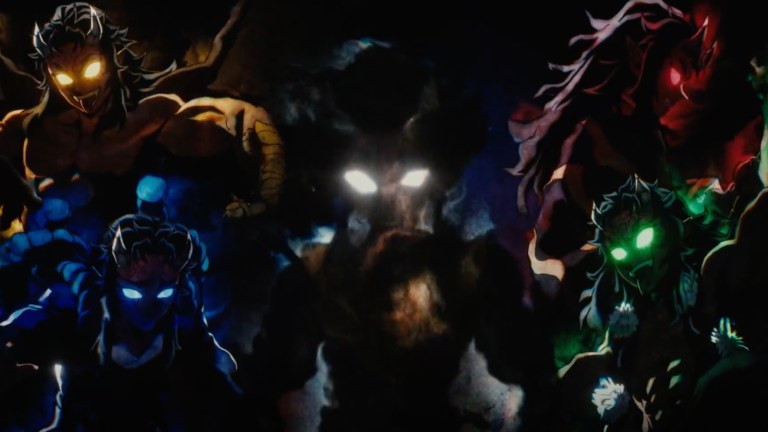Demon Slayer Season 3 Episode 7 Review: Awful Villain
Tanjiro’s demonic duel with Hantengu takes on yet another unexpected transformation as Demon Slayer begins to spin its wheels.

This Demon Slayer review contains spoilers.
Demon Slayer Season 3 Episode 7
“You don’t need a reason to help people.”
At first glance, the title of the latest Demon Slayer: Kimetsu no Yaiba episode, “Awful Villain,” has a very straightforward meaning. Hantengu and Gyokko represent some of the deadliest demons that Tanjiro has ever faced, but “Awful Villain” asks the audience to consider if it’s perhaps Tanjiro and Nezuko who are the real enemies in this story. “Awful Villain” is a Demon Slayer entry that’s still dense in combat and twists. However, the episode’s primary goal is to argue that the recent massacres of these Upper Rank demons are actually justified and are for the greater good, while the “heroes” represent the real problem.
This is a powerful idea to entertain, but it’s unfortunately not fresh territory for the shonen series. Demon Slayer has successfully made its audience empathize with past villains, but it’s not so easy this time around. Hantengu and Gyokko are long past the point of redemption, unlike other demons who have been humanized in the eleventh hour before their executions. It’s this fatal assumption, as well as repetitive battle stunts, that hold back “Awful Villain” from greater heights.
The conclusion of “Aren’t You Going to Become a Hashira?” teased a battle breakthrough for the Hashira, which makes it frustrating that “Awful Villain” is another case of two steps forward, one step back. Tanjiro is unable to execute Hantengu’s puniest form because his stronger state has absorbed three of his clones to become his strongest state, Zohakuten. Zohakuten has an excellent design that also results in some of the episode’s most magnetic moments where Tanjiro races down sprawling snake-like dragons with precise aerial choreography. However, this does reek of standard battle shonen shenanigans where a villain suddenly reveals another transformation that represents their full power, for real this time. We’ll see how Demon Slayer wraps all of this up but a four-on-one demon showdown seemed exciting enough without yet another complication.
The first half of “Awful Villain” gets consumed with Hantengu’s metamorphosis into his stronger fused form, Zohakuten, while the second act concentrates on the grander philosophical debate over villainy that Zohakuten poses to Tanjiro. It’s compelling food for thought, but in this specific situation the Hashira are not more culpable than Muzan Kibutsuji’s demons, so Tanjiro isn’t struck by any unexpected pangs of guilt. This conversation may have been more effective if it was had earlier in the season during the height of Genya and Nezuko’s violence.
Demon Slayer continues to return to Muichiro Tokito’s fight against Gyokko in a manner that’s almost comical. There’s not much depth that’s added to this fight as Tokito continues to drown as his Mist Breathing techniques fall short to break him free from Gyokko’s aquatic prison. What sets this installment apart from the past few Demon Slayer episodes is that Tokito experiences a vision of Tanjiro that helps him find the strength to escape. That being said, while Tokito finds the courage to continue, he’s still yet to actually break free.
These visions reinforce that the future isn’t set in stone and that none of us are doomed to live out predetermined destinies even if matters may currently look hopeless. Tanjiro’s endless selflessness–what separates him from the “awful villains” of the world–becomes a valuable counterpoint to Gyokko’s vicious quest to break Tokito’s concentration. This Upper Rank demon longs to shatter a hero’s spirit more than he wants to actually kill them, which resonates with Tanjiro’s lasting desire to change lives and spread hope rather than purely kill monsters.
Hantengu and Gyokko’s initial attack against Tanjiro, Nezuko, and Tokito hits with greater intensity than season two’s extended fight with Gyutaro and Daki in the Entertainment District. Each installment has added a new dimension to this battle and “Awful Villain” is no exception, but this is the first time that Demon Slayer really feels like it’s treading water and that these Upper Rank demons are the third season rather than just one of several obstacles. There’s still a lot to celebrate in Demon Slayer, but its recent obsession with filling an entire season with a single battle isn’t the right strategy for the series to adopt.
It’s not exactly a puzzling formula since Demon Slayer’s fights have become the series’ biggest talking points, but this prolonged approach ends up diluting the show’s secret weapon. “Awful Villain,” like every other episode from this season, still contains knockout visuals from ufotable. However, each stylized decapitation and sword strike grow a little duller when they flood episodes to little lasting effect. This reaches even greater diminishing returns thanks to Demon Slayer’s perplexing decision to bench Zenitsu and Inosuke for the entire season. If nothing else, their last-minute addition to the battlefield would at least bring something genuinely different to this fight.
In a vacuum, “Awful Villain” is a perfectly serviceable Demon Slayer entry, but there’s absolutely no reason why its events couldn’t be combined with last week’s complications. To go one step further, this fight against Hantengu and Gyokko would be its strongest if it were to be condensed down to three or four episodes rather than double that length. It creates a natural ambivalence towards the events of the season even though the stakes continue to get higher in every episode. It feels increasingly obvious that Demon Slayer will trip over itself and withhold any real breakthroughs until the season’s final episode. Just like how Tanjiro and Muichiro’s standard tactics are failing to work, Demon Slayer too needs to develop new strategies to keep its audience invested while the typical monster massacre mayhem falls short.
